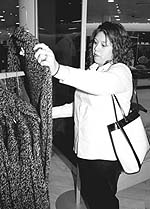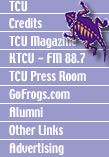|
Tuesday,
November 27, 2001
Winter
Gear
A
variety of coat styles are available to keep consumers warm
By
Antoinette Vega
Skiff Staff
One day
it feels like a blizzard outside, and the next it feels like
a desert.
Texas
weather is known for going from one extreme to the next. The
temperature is often unpredictable and it is hard enough deciding
what to wear while getting dressed in the morning, let alone
deciding on the kind of winter jacket to buy. This is especially
true for students from states other than Texas.
“Compared
to Minnesota, the weather in Texas is very frustrating,”
said Katy Belot, a sophomore political science major. “Here,
it is cold and dreary in the morning, and then in the afternoon
it gets sunny.”
When
shopping for a winter coat, the consumer is faced with a variety
of choices. Each store has its own variation of a certain
style and its own idea of its proper price. Shanelle Reyes,a
sophomore pre-major, needs a new winter coat, and there are
four elements a consumer looks for while shopping for outerwear:
style, comfort, durability and price.
Style
During
a trip to any mall, it is visible that leather, suede and
wool are the top fabrics for this winter season. Black, chocolate
brown and camel are the hottest colors this winter with some
coats featuring extras such as fur and fringe on collars and
sleeve cuffs. The most popular garment this year is the sweater
jacket available in a long or short length with buttons or
zippers in every color imaginable. The piece is casual yet
trendy making it easy to match with a pair of jeans or black
pants. Each store has its own variation of what to call the
item with names such as sweater coat, sweater duster, sweater
wrap or the boyfriend cardigan. Despite what it is called,
its comfort and style quality ensures that the sweater jacket
will be around for a long time.
Other
new additions for male and female consumers are pea coats
and suede jackets with funky collars. The pea coat is a double
breasted coat with a large collar with a classy look that
is popular with the business person and the college student.
Suede has always been a popular fabric for a jacket, but it
had a different look this year. This season has introduced
a new breed of suede coat decked out with collars and sleeve
cuffs made with plushed cotton or fur.
 Ski
jackets are also back this year exhibiting warmth and comfort.
Leather jackets are a popular classic available ever year
because of their stylish and versatile appeal. For many people,
style is number one on their list, but Reyes considers that
aspect as a second priority. Ski
jackets are also back this year exhibiting warmth and comfort.
Leather jackets are a popular classic available ever year
because of their stylish and versatile appeal. For many people,
style is number one on their list, but Reyes considers that
aspect as a second priority.
“Finding
a jacket that is warm is my first priority,” said Reyes.
“But style is important because if it is not something
I find appealing or doesn’t go with my clothing, then
I am not going to wear it.”
Comfort
Comfort
is marked by a feeling of content in the mind and body, and
this feeling should be found in the perfect coat.
The most
important factor that determines comfort is fabric. Among
a few of the fabrics to choose from are cotton, suede, polyester,
leather, wool and corduroy. Each type has different positives
and works differently with each person’s body. Cotton
is absorbent, retains a soft feeling and is comfortable for
most people. Polyester is ultra fine, soft and luxurious and
insulates well against the wind, rain and cold. Wool, made
from animal hair, is light-weight and a good insulator, but
can feel irritating and scratchy to the skin.
“I
am open to different fabrics and linings.” said Reyes.
“I’ll usually try on different coats to determine
what is the most comfortable to me.”
Choosing
a coat that is comfortable for the fluctuating Texas weather
is more complicated. When the temperature is 30-degrees or
below a wool or ski jacket would be effective in keeping warm.
But for the days when the temperature is warmer, a lighter
jacket would be more suitable.
“I
have two coats because the weather in Texas is different daily,”
said Scott Hamilton, a junior e-business major. “I have
a leather jacket that is stylish and a ski jacket for colder
weather and outdoor activities.”
Durability
Most
consumers do not want to purchase a new winter coat every
year, so when they do make a coat purchase, the garment needs
to last.
“I
don’t want to have to buy a coat every year,” said
Lance Bachim, a junior political science major. “If I
am going to buy a coat, I want it to be made out of good material
so that it will last for a while.”
Among
the materials available it is debatable on which is the better
buy. Cotton is durable, machine washable and can also be dry-cleaned.
Wool is washable and wrinkle resistant. Acrylic, nylon and
polyester are washable with outstanding durability and resistant
to wear, abrasion and soil. Leather is easy to clean and its
durability depends upon the nature of the leather. The leather
to look for is the Full Top Grain Leather.
“It
is important that the coat I choose will be able to endure
the weather and be easy to clean,” said Reyes. “I
don’t want it to give out on me or be hard to maintain.”
Price
With
winter coats, the phrase, “you get what you pay for”
is a proper one. Coats range on an average of $40 to $400
depending on the fabric and the brand name. A person who does
not want to spend a lot of money may find themselves out in
the cold if their purchase proves to be less comfortable or
less durable than others available. Those who pay more may
see the coat as a good investment. Because the item is more
expensive, it may last longer and feel more comfortable.
However,
there are exceptions. For example, a name brand ski jacket
at a department store costs twice the amount of one found
at the clothing store, The Gap. Also, a pea coat at Express
is almost twice as much as one from Old Navy.
For many
consumers, comparison shopping proves effective in saving
money and getting a better deal on a coat.
“I
will pay a higher price if the coat is worth it,” said
freshman business major Natalie Schulter. “I try to comparison
shop so I will have options on what to buy.”
But many
consumers will pay for the coat that they want no matter what
the cost is.
“I won’t go overboard on spending.” said Reyes.
“But if I find something that I like and have to have,
I will buy it.”
Antoinette Vega
a.c.vega@student.tcu.edu
|
